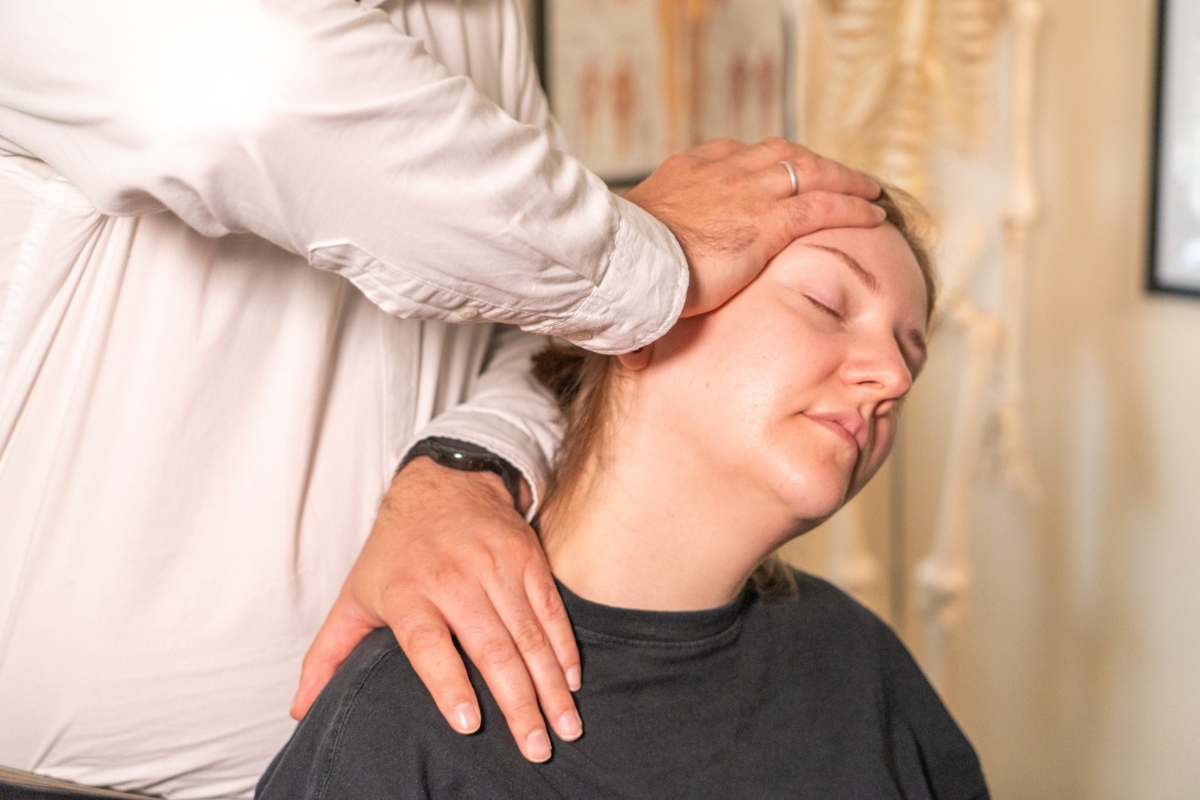Tension isn’t just an emotional stress—it’s a physical reality that shows up in tight muscles, restricted joints, and nagging discomfort. Left unchecked, it can escalate into headaches, poor posture, and even chronic pain. This guide explains what tension really is, why it happens, and how our chiropractic approach could help you unwind, both physically and mentally.
What Is tension?
Tension refers to the sustained contraction or shortening of muscle fibres and surrounding connective tissue. When muscles stay in a semi-contracted state—often due to stress, poor posture, or repetitive motions—they lose elasticity and create “knots” or trigger points. These tight spots may irritate nerves, restrict joint movement, and can refer pain to other areas of the body. Recognising tension as a complex issue; combining physical, emotional, and lifestyle factors, is the first step toward lasting relief.

Common causes of tension
- Poor posture: Slouching at your desk or hunching over devices places constant load on neck and shoulder muscles. Find out more
- Repetitive strain: Tasks like typing, lifting, or driving can overwork specific muscle groups over time.
- Emotional stress: Anxiety and stress trigger the body’s “fight or flight” response, making muscles tense up for protection.
- Dehydration and nutrition: Lack of water electrolytes leads to muscle cramps; a diet low in magnesium or calcium impairs relaxation.
- Sedentary lifestyle: Prolonged sitting reduces blood flow, making it harder for muscles to release built-up tension.
Signs and symptoms of tension
- Persistent muscle tightness: You might feel stiffness in your neck, shoulders, or lower back.
- Localised knots: Small, sore nodules in muscles that hurt when pressed.
- Headaches: Tension in the upper back and neck often leads to tension-type headaches. Find out more
- Restricted range of motion: Difficulty turning your head, bending forward, or lifting arms overhead.
- Fatigue and irritability: Constant discomfort drains energy and affects mood.
How chiropractic care alleviates tension
Chiropractic isn’t about just cracking spines—it’s a holistic system designed to restore balance and mobility across your entire body. Here’s some methods we may use to target tension:
- Spinal manipulations Precise, gentle thrusts are designed to loosen and realign vertebrae, reducing muscle guarding and nerve irritation. Link to manipulation page
- Soft tissue therapy
- Trigger point technique
- Vibration massage
- Active release technique
The above techniques can help to break down adhesions, loosening muscle and improving circulation. - Mobilisation Slow, repetitive joint movements enhance synovial fluid flow, lubricating joints and allowing muscles to relax around them. Link to mobilisation page
- Rehabilitation protocols: Tailored stretches and strengthening exercises tackle muscle imbalances, ensuring your body maintains better posture and resists future tension buildup.
Self-care strategies to reduce tension
While chiropractic care kick-starts your recovery, these daily habits keep tension at bay:
- Ergonomic workspace: Position your monitor at eye level, use a supportive chair, and keep your feet flat on the floor.
- Posture breaks: Set a timer to stand, stretch, and roll your shoulders every 30–45 minutes.
- Hydration and nutrition: Drink at least 2 litres of water daily and eat magnesium-rich foods like spinach, nuts, and whole grains.
- Stress management: Practice mindfulness, deep-breathing exercises, or yoga to calm the nervous system.
- Sleep support: Choose a supportive mattress and pillow combo that keeps your spine neutral from neck to hips.
When to seek professional chiropractic care
If tension persists beyond two weeks, worsens with activity, or begins to radiate into arms and legs, it is time for an expert evaluation. Chronic tension could be masking more serious issues like nerve impingement or joint degeneration. Early chiropractic intervention aims to not only soothe symptoms but also help prevent longer-term damage.
What to expect during your visit
Your first appointment is a collaborative journey:
- Detailed consultation We review your medical history, daily habits, and specific tension patterns.
- Physical exam Posture analysis, orthopaedic and neurological tests, and palpation, pinpoint your complaints root causes.
- Customised treatment plan You receive a care plan outlining your diagnosis, prognosis and treatment frequency.
- Education and empowerment We help you to understand the fundamentals of your problem, teach you posture cues, ergonomic tweaks, and stress-relief techniques so you remain in control of your progress.
Is tension dominating your life? Are you ready to break free from tension’s grip?
Get in touch
At Acomb Chiropractic Clinic, we are committed to helping you if we can. If you suspect that your discomfort may be related to tension, or if you are experiencing persistent back/neck pain, we encourage you to contact us for a personalised consultation. Our experienced chiropractic team will conduct a thorough assessment, explain our findings and what we think is possible in clear terms. If appropriate, we will develop a personalised treatment plan tailored to your specific condition and goals, aiming to maximise your possible benefit.
Not all complaints are appropriate for chiropractic care: If we think we cannot help your complaint, or you require more investigations, we will do our best to support you in finding you another path forward.
